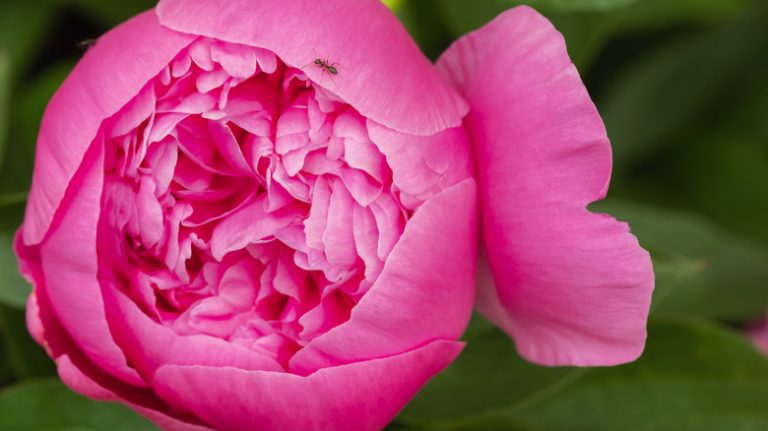Winter heaving is a common problem that peonies face during the cold months. These beautiful flowers, with their vibrant yellow color and double bloomer variety, need extra care during winter. If you have peonies in your garden, it is important to take proper care of them to ensure their health and longevity. In this article, we will explore the causes of winter heaving and provide tips on how to prevent it.
Peonies are hardy plants and can tolerate cold winters, however, they are susceptible to the freezing and thawing cycles that occur during the winter months. The freezing temperatures cause the soil to expand, which leads to the roots being pushed out of the ground. This process is known as heaving and can be damaging to the plant if left unchecked.
One way to prevent winter heaving is by mulching around the base of the peony plant. This helps to insulate the soil and prevent the freezing and thawing cycles from affecting the roots. It is important to use mulch that is quick to break down, such as shredded bark or compost, so that the new shoots can easily push through in the spring.
Another way to prevent winter heaving is by trimming the foliage of the peony plant before the first frost. This helps to redirect the energy to the roots and promote healthier growth. Be sure to trim the branches of the plant down to about an inch above the ground. This will also help to prevent diseases and pests from overwintering on the plant.
If you notice that your peony plant has heaved during the winter, do not panic. You can gently press the soil back into place and wait for the plant to settle before adding mulch. It is important to wait until the ground has thawed completely before doing any work on the plant. This will prevent further damage to the roots.
If you have any more questions about winter heaving or caring for peonies in general, feel free to ask our editor. Our nursery has years of experience growing and caring for peonies, and we are more than happy to help. Remember, proper care during winter is essential for the health and blooming of your peonies in the coming years.
Pruning Mistakes That Will Ruin Your Peony
When it comes to pruning your peony, it’s important to know what mistakes to avoid. Pruning is an essential part of caring for your peony plant, but if done incorrectly, it can have negative consequences for the health and blooming of your peonies.
One common mistake that many people make is pruning too much of the plant’s branches. While it may seem like a good idea to trim away any excess growth, this can actually harm your peony. The branches of a peony plant are where the buds and flowers will develop, so removing too many branches can result in fewer blooms the following year.
Another mistake to avoid is pruning at the wrong time of year. Peonies should be pruned in late winter or early spring, before new growth starts to emerge. Pruning too early can leave the plant vulnerable to frost damage, while pruning too late can inhibit the growth of new shoots.
Be careful when pruning near the base of the plant, as peony roots are relatively shallow. The bark and tissue just beneath the surface of the soil are important for the plant’s health and should not be damaged. If you need to remove a branch or stem, make sure to do so just above a leaf node, where new growth will develop.
While pruning can help improve the overall appearance of your peony plant, it’s important to remember the old saying “less is more.” Peonies are hardy plants and don’t require excessive pruning to thrive. In fact, over-pruning can weaken the plant and make it more susceptible to diseases and pests.
One mistake that many peony growers make is not mulching their plants during the winter. Mulching helps insulate the roots and protect them from frost heaving, which can occur in areas with cold winters. A layer of organic mulch, such as straw or shredded leaves, should be applied around the base of the plant before the first frost.
If you have any questions about pruning or caring for your peonies, don’t hesitate to reach out to us. You can email us at info@peonyfarm.com or give us a call at (555) 123-4567. Our team of experts is always here to help answer any questions you may have.
In conclusion, pruning is an important part of peony care, but it’s important to do it correctly. Avoid pruning mistakes such as removing too many branches, pruning at the wrong time of year, damaging the roots, and over-pruning. By following these guidelines and properly caring for your peony, you can ensure its health and enjoy beautiful blooms year after year.
Don’t Trim After Blooming
If you’re an editor, you’ve probably withered away countless hours answering questions about peony care, especially during the winter. One of the most common questions we get is whether or not to prune peony stems after they have finished blooming. And the answer is simple: don’t trim them!
Pruning peonies after blooming may seem like a good idea because it helps keep your gardens tidy and neat. However, it can actually do more harm than good. Peony stems act as a protective layer for the plant during the winter, shielding it from the harsh winter conditions. These stems also provide support for new growth the following year.
Mulching is another important step in peony care. Mulching helps insulate the roots and prevents them from freezing during the winters. The mulch also helps to retain moisture in the soil, which peonies need to thrive. However, be careful not to mulch too close to the base of the plant, as this can cause the plant to rot.
So why should you leave the pruning until the following year? Peonies have what is called “eyes,” which are small red buds that form at the base of the plant. These eyes are the future blooms for the next year, and cutting them away during pruning can result in fewer flowers.
Peonies are hardy plants that can withstand the winter temperatures without any problem. In fact, they actually require a period of cold weather in order to bloom to their full potential. Therefore, unless you live in an area with extremely harsh winters, it’s best to let nature take its course and leave the pruning for the spring.
If you have any more questions about peony care, feel free to join our growing community of peony enthusiasts here at the Salem Farm. We’re always happy to help and provide you with the information you need to ensure your peonies thrive.
For more information on peony care, you can also check out our website or email us with any specific questions you may have. We have a wide variety of peony plants available, from the classic Paeonia lactiflora to the stunning Paeonia maxima, which boasts vibrant colors and large blooms.
Don’t make the mistake of pruning your peonies too early. Follow our directions and care for your peonies with the love and attention they deserve. Your peonies will thank you with a beautiful blooming season every year.
Why Pruning Needs to Wait
Pruning peonies is a task that many gardeners are frequently asked about. When it comes to the health and care of peony plants, it’s important to know when and how to prune properly to ensure the best results.
During the winter months, peonies experience a natural phenomenon known as winter heaving, especially in colder areas. This is when the freezing and thawing of the soil causes the roots to be pushed upwards towards the surface. If you trim or prune your peonies too early, you risk damaging these delicate roots which can lead to stunted growth or even the death of the plant.
While it may be tempting to quickly trim away any dead or damaged foliage as soon as winter ends, it’s best to wait until all signs of frost have passed and the ground has completely thawed. In fact, it’s recommended to wait until late spring or early summer to prune your peonies to give them the time they need to recover from winter heaving.
If you’re unsure when exactly to prune your peonies, a good rule of thumb is to wait until you see new growth emerging from the ground. This is a strong indication that the plant has survived the winter and is ready for pruning.
When it comes time to prune, be sure to follow these directions carefully:
- Start by removing any dead or broken branches.
- Next, trim back any remaining foliage to about 2-3 inches above ground level.
- If you have mulched around your peonies, be careful not to trim the mulch along with the foliage.
- After pruning, you can consider applying a layer of shredded bark or compost around the base of the plants to help retain moisture and suppress weed growth.
It’s worth noting that not all peony varieties need to be pruned every year. In fact, some hardy varieties, like the Paeonia maxima, actually prefer to be left untouched. If you’re unsure about the pruning needs of your specific peony variety, it’s always a good idea to consult a local nursery or horticultural expert for guidance.
So, while it may be tempting to prune your peonies as soon as winter ends, it’s best to wait until the right time when the danger of frost has passed and the plants have had a chance to recover. By being patient and following proper pruning techniques, you can help ensure that your peonies will continue to thrive and bloom beautifully for years to come.
When to Prune
If you are growing peonies in your garden, you may wonder when is the best time to prune them. Actually, peonies don’t require much pruning, but a little trim can help promote healthy growth and prevent winter damage.
In most areas, it’s best to prune peonies in late fall or early winter, after the first hard frost has killed back the foliage. This is because peonies are cold weather plants and need the winter months to go dormant. Pruning them too early in the fall may result in new growth that won’t have enough time to harden off before the first winter frost.
When pruning your peonies, you want to focus on removing any dead or damaged branches and stems. Look for any withered or shriveled stems and remove them at the base. Trim away any branches that are crossing or rubbing against each other, as well as any that are growing towards the center of the plant. This will help open up the plant and promote better air circulation.
Some peony types, such as the tree peony (Paeonia suffruticosa) and the Itoh peony (Paeonia x ‘Bartzella’), have woody stems and bark that provide additional protection in winter. If you have these types of peonies, be careful not to remove too much of the woody growth.
If you’re not sure about pruning your peonies, it’s always a good idea to ask a local nursery or email a peony expert for advice. They can provide more specific information based on your growing zone and peony variety.
Overall, peonies are hardy plants that are tolerant of cold winters, so a quick trim in late fall or early winter will usually be enough to keep them healthy and blooming. Just remember to wait until after the first hard frost and be careful not to remove too much of the woody growth. Happy pruning!




